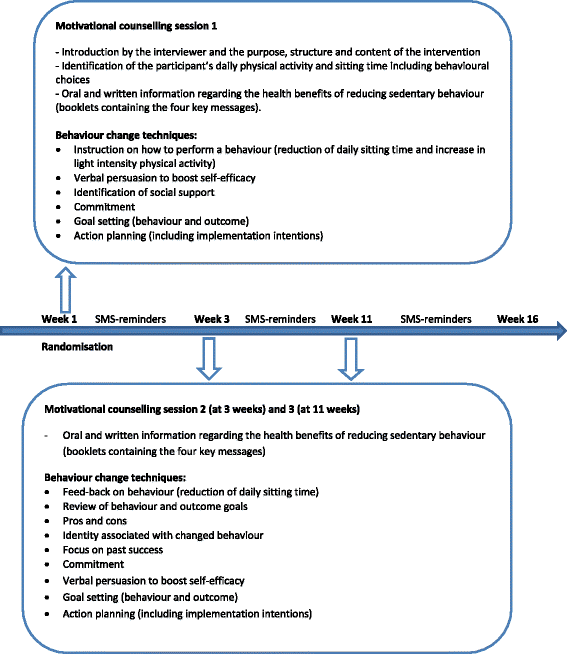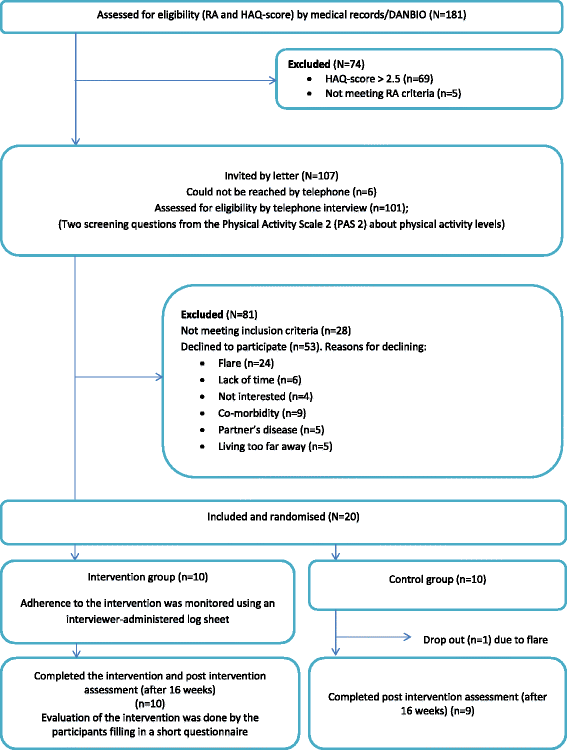Motivational counselling and SMS-reminders for reduction of daily sitting time in patients with rheumatoid arthritis: a descriptive randomised controlled feasibility study
- PMID: 27756265
- PMCID: PMC5070122
- DOI: 10.1186/s12891-016-1266-6
Motivational counselling and SMS-reminders for reduction of daily sitting time in patients with rheumatoid arthritis: a descriptive randomised controlled feasibility study
Abstract
Background: Patients with rheumatoid arthritis (RA) spend a high proportion of their waking time in sedentary behaviour (SB) and have an increased risk of cardiovascular disease. Reduction of SB and increase in light intensity physical activity has been suggested as a means of improvement of health in patients with mobility problems. Short-term intervention studies have demonstrated that SB can be reduced by behavioural interventions in sedentary populations. To evaluate descriptively the feasibility of recruitment, randomisation, outcome assessments, retention and the acceptability of an individually tailored, theory-based behavioural intervention targeting reduction in daily sitting time in patients with RA.
Methods: A randomised, controlled trial with two parallel groups. RA patients >18 years of age and Health Assessment Questionnaire (HAQ) score < 2.5 were consecutively invited and screened for daily leisure time sitting > 4 h. The 16-week intervention included 1) three individual motivational counselling sessions and 2) individual text message reminders aimed at reducing daily sitting time. The control group was encouraged to maintain their usual lifestyles. Outcomes were assessed at baseline and after the 16 week intervention. Daily sitting time was measured using an ActivPAL3TM activity monitor. The study was not powered to show superiority; rather the objective was to focus on acceptability among patients and clinical health professionals.
Results: In total, 107 patients were invited and screened before 20 met eligibility criteria and consented; reasons for declining study participation were mostly flares, lack of time and co-morbidities. One patient from the control group dropped out before end of intervention (due to a RA flare). Intervention participants completed all counselling sessions. All procedures regarding implementation of the trial protocol were feasible. The daily sitting time was reduced on average by 0.30 h in the intervention group unlike the control group that tended to increase it by 0.15 h after 16 weeks.
Conclusions: This study shows that an individually tailored behavioural intervention targeting reduction of SB was feasible and acceptable to patients with RA.
Trial registration: The Danish Data Protection Agency (ref.nb. 711-1-08 - 20 March 2011), the Ethics Committee of the Capital Region of Denmark (ref.nb. H-2-2012-112- 17 October 2012), clinicaltrials.gov ( NCT01969604 - October 17 2013, retrospectively registered).
Keywords: Acceptability; ActivPAL; Cardiovascular biomarkers; Fatigue; Individually tailored behavioural intervention; Pain; Self-efficacy; Text messages.
Figures
Similar articles
-
The efficacy of motivational counseling and SMS-reminders on daily sitting time in patients with rheumatoid arthritis: protocol for a randomized controlled trial.Trials. 2015 Jan 27;16:23. doi: 10.1186/s13063-014-0540-x. Trials. 2015. PMID: 25623388 Free PMC article. Clinical Trial.
-
The efficacy of motivational counselling and SMS reminders on daily sitting time in patients with rheumatoid arthritis: a randomised controlled trial.Ann Rheum Dis. 2017 Sep;76(9):1603-1606. doi: 10.1136/annrheumdis-2016-210953. Epub 2017 Jun 5. Ann Rheum Dis. 2017. PMID: 28584189 Free PMC article. Clinical Trial.
-
Sustained Long-Term Efficacy of Motivational Counseling and Text Message Reminders on Daily Sitting Time in Patients With Rheumatoid Arthritis: Long-Term Follow-up of a Randomized, Parallel-Group Trial.Arthritis Care Res (Hoboken). 2020 Nov;72(11):1560-1570. doi: 10.1002/acr.24060. Arthritis Care Res (Hoboken). 2020. PMID: 31507095 Clinical Trial.
-
Motivational Counseling and Text Message Reminders: For Reduction of Daily Sitting Time and Promotion of Everyday Physical Activity in People with Rheumatoid Arthritis.Rheum Dis Clin North Am. 2019 May;45(2):231-244. doi: 10.1016/j.rdc.2019.01.005. Rheum Dis Clin North Am. 2019. PMID: 30952395 Review.
-
Sedentary behaviour in rheumatoid arthritis: definition, measurement and implications for health.Rheumatology (Oxford). 2018 Feb 1;57(2):213-226. doi: 10.1093/rheumatology/kex053. Rheumatology (Oxford). 2018. PMID: 28398519 Review.
Cited by
-
The behavioural epidemiology of sedentary behaviour in inflammatory arthritis: where are we, and where do we need to go?Rheumatol Adv Pract. 2023 Jan 24;7(1):rkac097. doi: 10.1093/rap/rkac097. eCollection 2023. Rheumatol Adv Pract. 2023. PMID: 36699551 Free PMC article. Review.
-
Effects of sedentary behaviour interventions on biomarkers of cardiometabolic risk in adults: systematic review with meta-analyses.Br J Sports Med. 2021 Feb;55(3):144-154. doi: 10.1136/bjsports-2019-101154. Epub 2020 Apr 8. Br J Sports Med. 2021. PMID: 32269058 Free PMC article.
-
The effectiveness and complexity of interventions targeting sedentary behaviour across the lifespan: a systematic review and meta-analysis.Int J Behav Nutr Phys Act. 2020 Apr 25;17(1):53. doi: 10.1186/s12966-020-00957-0. Int J Behav Nutr Phys Act. 2020. PMID: 32334631 Free PMC article.
-
The role of non-pharmacological interventions in the management of rheumatoid-arthritis-related fatigue.Rheumatology (Oxford). 2019 Nov 1;58(Suppl 5):v22-v28. doi: 10.1093/rheumatology/kez310. Rheumatology (Oxford). 2019. PMID: 31682276 Free PMC article. Review.
-
Theory-informed interventions to promote physical activity and reduce sedentary behaviour in rheumatoid arthritis: a critical review of the literature.Mediterr J Rheumatol. 2020 Mar 31;31(1):19-41. doi: 10.31138/mjr.31.1.19. eCollection 2020 Mar. Mediterr J Rheumatol. 2020. PMID: 32411931 Free PMC article. Review.
References
-
- Hewlett S, Sanderson T, May J, Alten R, Bingham III CO, Cross M, March L, Pohl C, Woodworth T, Bartlett SJ. 'I'm hurting, I want to kill myself': rheumatoid arthritis flare is more than a high joint count--an international patient perspective on flare where medical help is sought. Rheumatology (Oxford). 2012;51(1):69–76. doi:10.1093/rheumatology/keq455. - PubMed
-
- Michaud K, Wolfe F. Comorbidities in rheumatoid arthritis. BestPractResClinRheumatol. 2007;21(5):885–906. - PubMed
-
- Linde L, Sorensen J, Ostergaard M, Horslev-Petersen K, Rasmussen C, Jensen DV, Hetland ML. What factors influence the health status of patients with rheumatoid arthritis measured by the SF-12v2 Health Survey and the Health Assessment Questionnaire? J Rheumatol. 2009;36(10):2183–2189. doi: 10.3899/jrheum.090134. - DOI - PubMed
Publication types
MeSH terms
Associated data
LinkOut - more resources
Full Text Sources
Other Literature Sources
Medical
Miscellaneous



